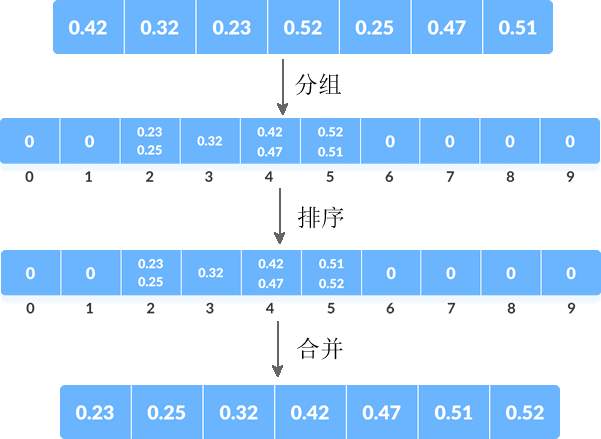桶排序(又称箱排序)是一种基于分治思想、效率很高的排序算法,理想情况下对应的时间复杂度为 O(n)。
假设一种场景,对 {5, 2, 1, 4, 3} 进行升序排序,桶排序算法的实现思路是:
- 准备 5 个桶,从 1~5 对它们进行编号;
- 将待排序序列的各个元素放置到相同编号的桶中;
- 从 1 号桶开始,依次获取桶中放置的元素,得到的就是一个升序序列。
整个实现思路如下图所示:

桶排序算法中,待排序的数据量和桶的数量并不一定是简单的“一对一”的关系,更多场景中是“多对一”的关系,例如,使用桶排序算法对 {11, 9, 21, 8, 17, 19, 13, 1, 24, 12} 进行升序排序,实现过程如下图所示:

待排序序列中有 10 个元素,但算法中只用了 5 个桶,因此有些桶需要存放多个元素。实际场景中,我们可以自定义各个桶存放元素的区间(范围),比如上图中第一个桶存放 [0,5) 区间内的元素,第二个桶存放 [6,10) 之间的元素。
当存在“一个桶中有多个元素”的情况时,要先使用合适的排序算法对各个痛内的元素进行排序,然后再根据桶的次序逐一取出所有元素,最终得到的才是一个有序序列。
总之,桶排序算法的实现思路是:将待排序序列中的元素根据规则分组,每一组采用快排、插入排序等算法进行排序,然后再按照次序将所有元素合并,就可以得到一个有序序列。

桶排序算法的C语言实现
假设用桶排序算法对 {0.42, 0.32, 0.23, 0.52, 0.25, 0.47, 0.51} 进行升序排序,采用的分组规则是:将所有元素分为 10 组,每组的标号分别为 0~9。对序列中的各个元素乘以 10 再取整,得到的值即为该元素所在组的组号。

使用桶排序算法解决此问题的 C 语言程序如下:

/**
* 系统学习C语言 https://xiecoding.cn/c/
**/
#include <stdio.h>
#include <stdlib.h>
#define N 7 // 待排序序列中的元素个数
#define NBUCKET 6 // 桶的数量
#define INTERVAL 10 // 每个桶能存放的元素个数
//建立桶
struct Node {
float data;
struct Node *next;
};
void BucketSort(float arr[]);
struct Node *InsertionSort(struct Node *list);
void print(float arr[]);
int main() {
float array[N] = { 0.42, 0.32, 0.23, 0.52, 0.25, 0.47, 0.51 };
BucketSort(array);
print(array);
return 0;
}
// 桶排序,arr 为待排序序列
void BucketSort(float arr[]) {
int i, j;
struct Node **buckets;
// 创建所有桶
buckets = (struct Node **)malloc(sizeof(struct Node *) * NBUCKET);
// 设置每个桶为空桶
for (i = 0; i < NBUCKET; ++i) {
buckets[i] = NULL;
}
// 根据规定,将 arr 中的每个元素分散存储到各个桶中
for (i = 0; i < N; ++i) {
struct Node *current;
int pos = arr[i] * 10; //根据规则,确定元素所在的桶
//创建存储该元素的存储块,并连接到指定的桶中
current = (struct Node *)malloc(sizeof(struct Node));
current->data = arr[i];
current->next = buckets[pos];
buckets[pos] = current;
}
// 调用自定义的排序算法,对各个桶进行排序
for (i = 0; i < NBUCKET; ++i) {
buckets[i] = InsertionSort(buckets[i]);
}
// 合并所有桶内的元素
for (j = 0, i = 0; i < NBUCKET; ++i) {
struct Node *node;
node = buckets[i];
while (node) {
arr[j++] = node->data;
node = node->next;
}
}
}
// 自定义的排序算法,用于对各个桶内元素进行排序
struct Node *InsertionSort(struct Node *list) {
struct Node *k, *nodeList;
if (list == NULL || list->next == NULL) {
return list;
}
nodeList = list;
k = list->next;
nodeList->next = NULL;
while (k != NULL) {
struct Node *ptr;
if (nodeList->data > k->data) {
struct Node *tmp;
tmp = k;
k = k->next;
tmp->next = nodeList;
nodeList = tmp;
continue;
}
for (ptr = nodeList; ptr->next != 0; ptr = ptr->next) {
if (ptr->next->data > k->data)
break;
}
if (ptr->next != 0) {
struct Node *tmp;
tmp = k;
k = k->next;
tmp->next = ptr->next;
ptr->next = tmp;
continue;
}
else {
ptr->next = k;
k = k->next;
ptr->next->next = 0;
continue;
}
}
return nodeList;
}
void print(float ar[]) {
int i;
for (i = 0; i < N; ++i) {
printf("%.2f ", ar[i]);
}
}
程序的输出结果为:
0.23, 0.25, 0.32, 0.42, 0.47, 0.51, 0.52
























 7297
7297

 被折叠的 条评论
为什么被折叠?
被折叠的 条评论
为什么被折叠?








